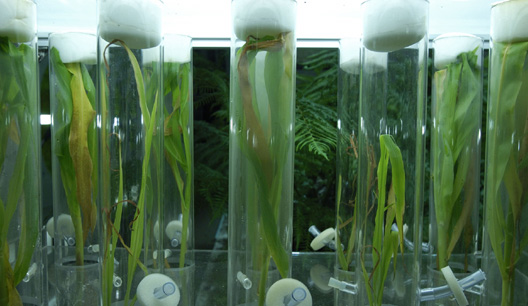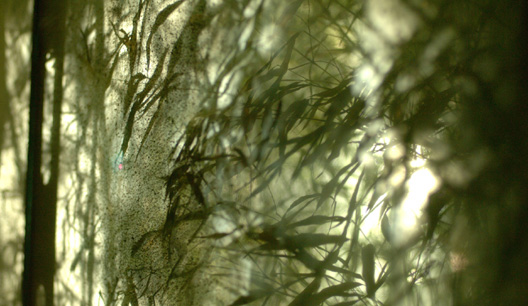Spaces of Food #2: Inflatable Greenhouses on the Moon
Continuing today's short series of posts, offered up as part of GOOD's ongoing food-blogging week, I thought I'd point your attention to an interesting architectural experiment in the U.S. southwest.
 [Image: Gene Giacomelli and his lunar greenhouse; photo by Norma Jean Gargasz courtesy of UANews].
[Image: Gene Giacomelli and his lunar greenhouse; photo by Norma Jean Gargasz courtesy of UANews].
Researchers at the University of Arizona's Controlled Environment Agriculture Center have devised a "lunar greenhouse" that "could be the key to growing fresh and healthy food to sustain future lunar or Martian colonies," Space reported back in October.
Under the guidance of Gene Giacomelli, "The team built a prototype lunar greenhouse in the CEAC Extreme Climate Lab that is meant to represent the last 18 feet (5.5 meters) of one of several tubular structures that would form part of a proposed lunar base. The tubes would be buried beneath the moon's surface to protect the plants and astronauts from deadly solar flares, micrometeorites and cosmic rays. As such, the buried greenhouse would differ from conventional greenhouses that let in and capture sunlight as heat. Instead, these underground lunar greenhouses would shield the plants from harmful radiation."
As Popular Science describes it:
Interestingly, Antarctica supplied a kind of natural test-environment for this architectural experiment: "the extreme conditions of the South Pole helped his team fine-tune their lunar greenhouse, and also allowed them to figure out how to remotely control conditions like temperature, humidity and light. He said similar technologies could also be used someday in cities—in a greenhouse in the middle floor of a skyscraper, for example. He added that, at least right now, the technology, and lighting, especially, are too expensive for daily commercial use."




 [Image: A glimpse inside the "oxygen garden" from Danny Boyle's film Sunshine; courtesy of DNA Films].
[Image: A glimpse inside the "oxygen garden" from Danny Boyle's film Sunshine; courtesy of DNA Films].
A long time ago, meanwhile, we looked at the idea of an "oxygen garden," pictured above, with its vision of locally networked plants, aeration devices, cylindrical growth chambers, and hydroponic vats for long-term space missions. But an oxygen garden is only one particular kind of non-terrestrial agriculture under cultivation right now.
As Popular Mechanics explain in their January 2011 issue, "Teams of scientists around the world—and above it, aboard the International Space Station—are trying to design farms for the diverse environments future explorers could encounter across the solar system." From "robotic farmers with articulate hands" operating inside inflatable greenhouses on the moon to microgravitational peas and radishes grown by the fantastically named Roscosmos, by way of greenhouses "that can endure Mars's low-pressure, high-carbon-dioxide environment" designed by the Italian Space Agency to the Arthur C. Clarke Mars Greenhouse (not mentioned by Popular Mechanics), these living experiments demonstrate how to use architecture as a way to frame unearthly environments here on earth—so that we can then bring earthly environments with us to other planets. It's the referential topology of interplanetary simulation.
In fact, repeating myself from the earlier oxygen garden post, I remain fascinated by and slightly in awe of the idea of what I call surrogate earths, whereby the earth enters into a chain of substitutions—a standardized economy of counterfeits and stand-ins, experimental surrogates and scientific stunt-doubles, all of which refer to, re-enact, and simulate a superceded original. These portable versions of the planet, from its climate and its soil to its viruses and bacteria, pop up everywhere from plans for hydroponic gardens, terrariums, and floating greenhouses to complex manned missions to the moon. And, if only for the purpose of growing vegetables, it is nonetheless extraordinary that we can use a finely tuned technological apparatus–including specialty fertilizers, nanofabrics, and UV lights–to reproduce terrestrial conditions elsewhere, in miniature.
—Spaces of Food #5: Madeira Odorless Fish Market and the Tempelhof Ministry of Food
—Spaces of Food #4: Betel Nut Beauties
—Spaces of Food #3: The Mushroom Tunnel of Mittagong
—Spaces of Food #2: Inflatable Greenhouses on the Moon
—Spaces of Food #1: Agriculture On-The-Go and the Reformatting of the Planet
 [Image: Gene Giacomelli and his lunar greenhouse; photo by Norma Jean Gargasz courtesy of UANews].
[Image: Gene Giacomelli and his lunar greenhouse; photo by Norma Jean Gargasz courtesy of UANews].Researchers at the University of Arizona's Controlled Environment Agriculture Center have devised a "lunar greenhouse" that "could be the key to growing fresh and healthy food to sustain future lunar or Martian colonies," Space reported back in October.
Under the guidance of Gene Giacomelli, "The team built a prototype lunar greenhouse in the CEAC Extreme Climate Lab that is meant to represent the last 18 feet (5.5 meters) of one of several tubular structures that would form part of a proposed lunar base. The tubes would be buried beneath the moon's surface to protect the plants and astronauts from deadly solar flares, micrometeorites and cosmic rays. As such, the buried greenhouse would differ from conventional greenhouses that let in and capture sunlight as heat. Instead, these underground lunar greenhouses would shield the plants from harmful radiation."
As Popular Science describes it:
- The 18-foot, membrane-sheathed system collapses into a 4-foot wide disk for easy packing on an interplanetary mission. When extended, it is fitted with water-cooled lamps and seed packets prepped to sprout without soil. They hydroponic system needs little oversight, relying on automated systems and control algorithms to analyze data gathered by embedded sensors that optimize the controlled ecosystem. The whole system takes just ten minutes to set up and produces vegetables within a month.
Interestingly, Antarctica supplied a kind of natural test-environment for this architectural experiment: "the extreme conditions of the South Pole helped his team fine-tune their lunar greenhouse, and also allowed them to figure out how to remotely control conditions like temperature, humidity and light. He said similar technologies could also be used someday in cities—in a greenhouse in the middle floor of a skyscraper, for example. He added that, at least right now, the technology, and lighting, especially, are too expensive for daily commercial use."




 [Image: A glimpse inside the "oxygen garden" from Danny Boyle's film Sunshine; courtesy of DNA Films].
[Image: A glimpse inside the "oxygen garden" from Danny Boyle's film Sunshine; courtesy of DNA Films].A long time ago, meanwhile, we looked at the idea of an "oxygen garden," pictured above, with its vision of locally networked plants, aeration devices, cylindrical growth chambers, and hydroponic vats for long-term space missions. But an oxygen garden is only one particular kind of non-terrestrial agriculture under cultivation right now.
As Popular Mechanics explain in their January 2011 issue, "Teams of scientists around the world—and above it, aboard the International Space Station—are trying to design farms for the diverse environments future explorers could encounter across the solar system." From "robotic farmers with articulate hands" operating inside inflatable greenhouses on the moon to microgravitational peas and radishes grown by the fantastically named Roscosmos, by way of greenhouses "that can endure Mars's low-pressure, high-carbon-dioxide environment" designed by the Italian Space Agency to the Arthur C. Clarke Mars Greenhouse (not mentioned by Popular Mechanics), these living experiments demonstrate how to use architecture as a way to frame unearthly environments here on earth—so that we can then bring earthly environments with us to other planets. It's the referential topology of interplanetary simulation.
In fact, repeating myself from the earlier oxygen garden post, I remain fascinated by and slightly in awe of the idea of what I call surrogate earths, whereby the earth enters into a chain of substitutions—a standardized economy of counterfeits and stand-ins, experimental surrogates and scientific stunt-doubles, all of which refer to, re-enact, and simulate a superceded original. These portable versions of the planet, from its climate and its soil to its viruses and bacteria, pop up everywhere from plans for hydroponic gardens, terrariums, and floating greenhouses to complex manned missions to the moon. And, if only for the purpose of growing vegetables, it is nonetheless extraordinary that we can use a finely tuned technological apparatus–including specialty fertilizers, nanofabrics, and UV lights–to reproduce terrestrial conditions elsewhere, in miniature.
—Spaces of Food #5: Madeira Odorless Fish Market and the Tempelhof Ministry of Food
—Spaces of Food #4: Betel Nut Beauties
—Spaces of Food #3: The Mushroom Tunnel of Mittagong
—Spaces of Food #2: Inflatable Greenhouses on the Moon
—Spaces of Food #1: Agriculture On-The-Go and the Reformatting of the Planet





Comments are moderated.
If it's not spam, it will appear here shortly!
Post a Comment